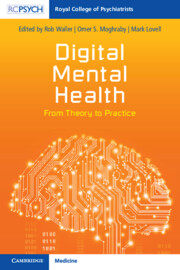Book contents
- Digital Mental Health
- Digital Mental Health
- Copyright page
- Contents
- Contributors
- Introduction
- Chapter 1 Working with IT Systems
- Chapter 2 Technology-Enabled Care
- Chapter 3 Note Keeping in the Digital Age
- Chapter 4 Big Data
- Chapter 5 Artificial Intelligence
- Chapter 6 Digital Clinicians
- Chapter 7 Global Telepsychiatry
- Chapter 8 The Integration Agenda
- Chapter 9 Digital Wellbeing
- Chapter 10 Conclusion
- Appendix: Abbreviations
- Index
- References
Chapter 5 - Artificial Intelligence
Why We Need It and Why We Need to Be Cautious
Published online by Cambridge University Press: 23 November 2023
- Digital Mental Health
- Digital Mental Health
- Copyright page
- Contents
- Contributors
- Introduction
- Chapter 1 Working with IT Systems
- Chapter 2 Technology-Enabled Care
- Chapter 3 Note Keeping in the Digital Age
- Chapter 4 Big Data
- Chapter 5 Artificial Intelligence
- Chapter 6 Digital Clinicians
- Chapter 7 Global Telepsychiatry
- Chapter 8 The Integration Agenda
- Chapter 9 Digital Wellbeing
- Chapter 10 Conclusion
- Appendix: Abbreviations
- Index
- References
Summary
The potential for artificial intelligence (AI) still attracts polarising views. There are clear benefits and dangers. The key is being aware of what these are and understanding that it is possible to utilise AI in psychiatry safely. There has to be to a will to do so as it is far more expensive to develop AI applications safely than it is to develop them at all. As shown however, there are hidden costs that make this a false economy. Ultimately, transparency about the inner workings of AI and machine learning tools makes increasing their safety realistic. It reduces the sense of magic but that is a small price to pay.
- Type
- Chapter
- Information
- Digital Mental HealthFrom Theory to Practice, pp. 60 - 71Publisher: Cambridge University PressPrint publication year: 2023



